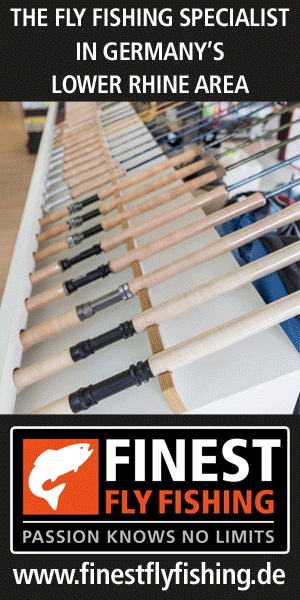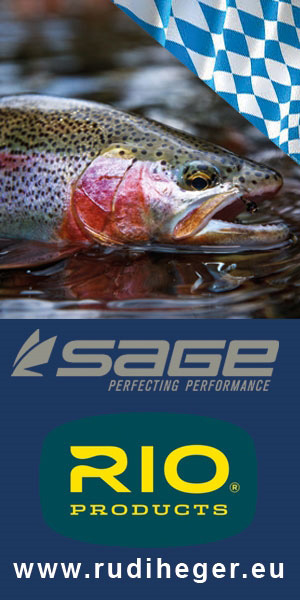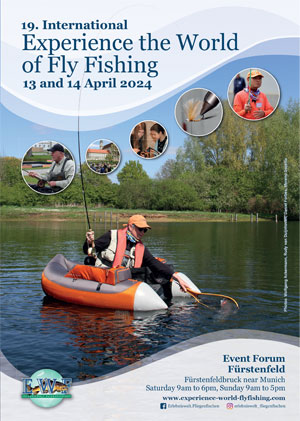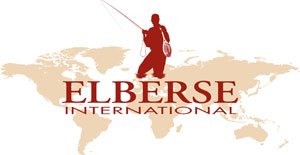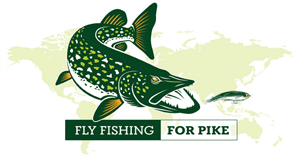
In autumn small nymphs are the name of the game on the San Juan River, but if you start early you can make a good head start with streamers and dry flies too. I learned this on a visit a number of years ago to this river, which is one of the best known trout fisheries in the world.
The best known section of the San Juan River, the three and a half mile long Catch & Release section below Navajo reservoir, is a typical tail water fishery. The water comes from a hundred meters down in the lake, is therefore only 4 or 5 degrees Celsius in temperature at the start of the fishery. As the river runs through a desert landscape, it warms up a number of degrees in the first few miles. Still the temperature remains low enough to support a healthy trout population, and that is probably an understatement. The number of trout per mile in the first section is huge, you see fish everywhere during a drift.

The fact that you drift over numerous trout does not seem to bother them; they keep on the feed, picking up nymphs left and right. Further down the river, in the section where it is allowed to keep fish and where one can fish with other methods, the number of trout per mile goes down, for obvious reasons. The private stretches that are found on the river, where no drift boats are allowed and ‘fly only’ is the rule once more, the stocks of trout and the quality of the fish are up again.

On the river bank
The Soaring Eagle Lodge is the only lodge in this area that is right on the river front and it has a private stretch of river running right past the apartments where the guests are staying. So on any day that you do not want to take a drift boat trip, you have the river right there on your door step. The Soaring Eagle Lodge, which is owned by Larry Johnson and Leslie A. Jedrey, was where we stayed for a few days after a trade show in September. It was a beautiful drive through the Rocky Mountains from Denver to New Mexico, without the several photo stops we made, it would have taken us about seven hours by car.

Pro Guide Rusty Hill picked Kate Blubaugh and myself up at the lodge the following morning for our first drift down the section. Even though we arrived early, we were surprised to see a number of drift boats were on the water already and there were more to follow behind us. Can you imagine a three and a half mile (5,6 kilometers) stretch of river with twelve drift boats with two anglers each plus a number of wading fly fishers that got access through several parking places? Even more surprising is the fact that all the traffic on the water does not seem to interfere with the fishing at all. The trout just keep rising or feeding on nymphs and other tiny creatures.

First things first
Rusty suggested that we start with streamers first, we would leave the fishing with tiny nymphs for a later moment. Rusty handed me a small weighted Clouser Minnow tied with soft hair, Kate received a Muddler pattern. Rusty had dropped the anchor at a good looking spot and I cast my streamer towards the bank on the left. The streamer sank into a deeper spot and when I started to strip it back, it was not long before I got a first hit! Another grab and than the fish was hooked solidly, it took along the loose line in my hands in a few seconds and than I could fight it on the reel. One would expect a sluggish fight as many of these fish are caught several times throughout the year, but this was not the case for sure. The fish was wildly mad and it took quite some time before a handsome rainbow trout made its way into the landing net.

Kate made a cast to the right hand side and a fish took her streamer on one of the first casts too, unfortunately it came off during the fight. A few more casts and she was into another fish; this time she managed to lead it to the net. A few quick pictures and than the fish did swam off again, a little wiser probably.

Going onwards
Casting straight across or angled somewhat downstream we fished our streamers back deep in the flow of water. This seemed to produce the most takes. Had a section of river been covered properly, than Rusty would bring up the anchor and we would drift onwards, in search of another promising piece of water. The sun had risen by now and flooded the desert valley that the river past through in light. Stones, hills and sand in different shades of yellow, brown and orange, with small amounts of green from the bushes and small trees here and there.

Some of the trout we saw were rising consistently, so Kate decided to try some dry flies as well. She put on her favorite, a small Adams, and started casting to some of the rises. It took several drag free casts before the fly was taken, Kate paused for a spilt second and than set the hook into another good sized fish. She brought it over the net, Rusty left the net outside the boot, unhooked the fish in the net quickly and let her swim of again. This way he could return the trout without having to touch it with his hands. Small dry flies and emergers brought up several more fish before the action on the surface faded away.

Small nymphs fished deep
The San Juan River is famous for the nymph fishing techniques that are used successfully here. Small nymphs, like thinly dressed goldbead nymphs in sizes 18 to 26, are used here most often and these are fished below a large size strike indicator, often called a ‘bobber’ in the USA. Some fly-fishers think that using a strike indicator has little to do with fly-fishing, they call it “bobber and jig fishing”, but without a strike indicator it is difficult to keep the nymphs at a certain depth and to see a strike when one of the nymphs is taken. Small nymphs are hard to get down in a flow, which is why a small split shot is used on the leader above the top fly or in between the two flies which are normally used here. The tiny split shot (or two) brings down the nymphs to the desired depth of perhaps six to eight feet and the strike indicator keeps the nymphs at that depth.

Whereas we in Europe are used to fish nymphs upstream, so we can sneak up on a trout from behind, the Americans cast their nymph more at an angle to the flow and let it drift much further downstream. While keeping a sharp eye on the bobber, they will bring out extra line in an effort to let the rig drift downstream without behaving unnaturally. Rusty placed the nymphs some 50 centimeters apart and added the weight he thought necessary for a certain spot. Whenever there is a considerable change in depth, the strike indicator is placed higher or lower on the leader. We used small balloon type strike indicators on the river, the air that is trapped inside them will keep them floating high and clearly visible. These balloon type strike indicators come in different sizes, from less than an inch overall up to the size of small golf balls.

Stop sign
We placed our rigs angled upstream and tried to make sure that they drifted down likely looking lanes in a drag free matter. Whenever the strike indicator suddenly stopped or was dragged under, we set the hook. Often it was just touching stones or weed, but just as often some mad pulls came from deep down, indicating we had successfully hooked yet another trout. Although we fished delicately, using 5X and 6X tippets, we only lost a few trout in the weeds. Whenever we hooked a nice fish, we would reel in the loose line that was hanging and lying in front of us and than fought the fish of the reel. This way there is less chance of the line getting tangled or getting snagged behind an obstacle in the boat, which would otherwise mean the loss of a nice fish. A fly reel with a proper drag system is worth its weight in gold here.

The area has a lot more to offer for the fly-fisherman and –woman. Our travelling partner Peter Elberse (owner of wholesale company Elberse International) caught some nice smallmouth bass and carp on the reservoir, in the season you can also try for northern pike and kokanee salmon there. Some of the quiet back waters of the San Juan River also hold carp and these ‘freshwater bonefish’ can grow to double figure weights quite easily in this warm environment.

Equipment
The Soaring Eagle Lodge has a full service fly shop next to the restaurant, furthermore there are several fly shops close to the fishery. Still it is good to bring the following items, when you have enough room in your suitcases: nine foot rods for line classes #4, 5 or 6 (#5 is the most used), floating lines in according weights, GoreTex waders with wading shoes that have felt or felt studded soles, a catch & release tool. Recommended clothing: breathable long johns, heavy woolen socks, sun check fishing shirt, polar tec fleece and a rain jacket. Personal items: 30+ sun screen, chap stick, polarizing sun glasses, hat, comfortable walking shoes, camera.
Text by Rudy van Duijnhoven, pictures by Rudy van Duijnhoven and Kate Blubaugh.

Information
Soaring Eagle Lodge
PO Box 6340
#48 Country Road 4370
Navajo Dam, NM 87419
USA
Tel. +1 505 632 3721
Fax +1 505 632 5621
Website: www.soaringeaglelodge.net
E-mail: info@soaringeaglelodge.net

Float ‘n Fish Fly Shop
PO Box 6460
Navajo Dam, NM 87419
USA
Tel. +1 505 632 5385
Fax +1 505 632 5388
E-mail: floatnfish@acrnet.com

Abe’s Motel & Fly Shop
1791 Hwy. #173
PO Box 6428
Navajo Dam, NM 87419
USA
Tel. +1 505 632 2194
Website: www.sanjuanriver.com
E-mail: abes1958@eartlink.net

Navajo Lake State Park
1448 NM 511, #1
Navajo Dam, NM 87419
USA
Tel. +1 505 632 2278
Website: www.nmparks.com

Wines of the San Juan
Winery & Tasting Room
233 Hwy. 511 at Turley
Blanco, NM 87412
USA
Tel. +1 505 632 0879
Website: www.winesofthesanjuan.com

Licenses:
Department of Game and Fish
PO Box 25112
Santa Fe, NM 87504

San Juan River – A Fly-Angler’s Journal
By Richard R. Twarog
ISBN 1-57188-373-8

